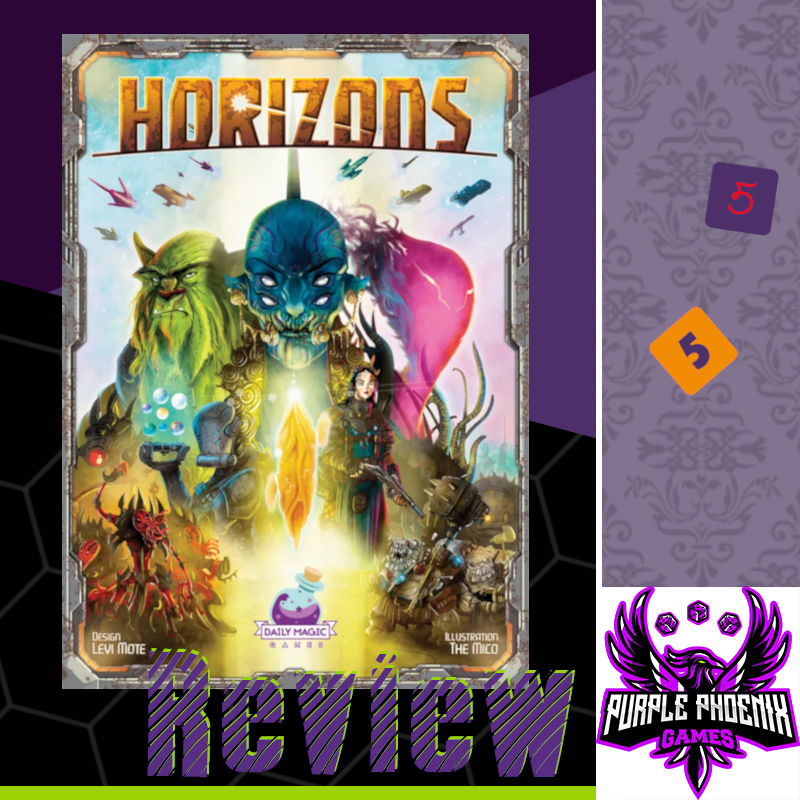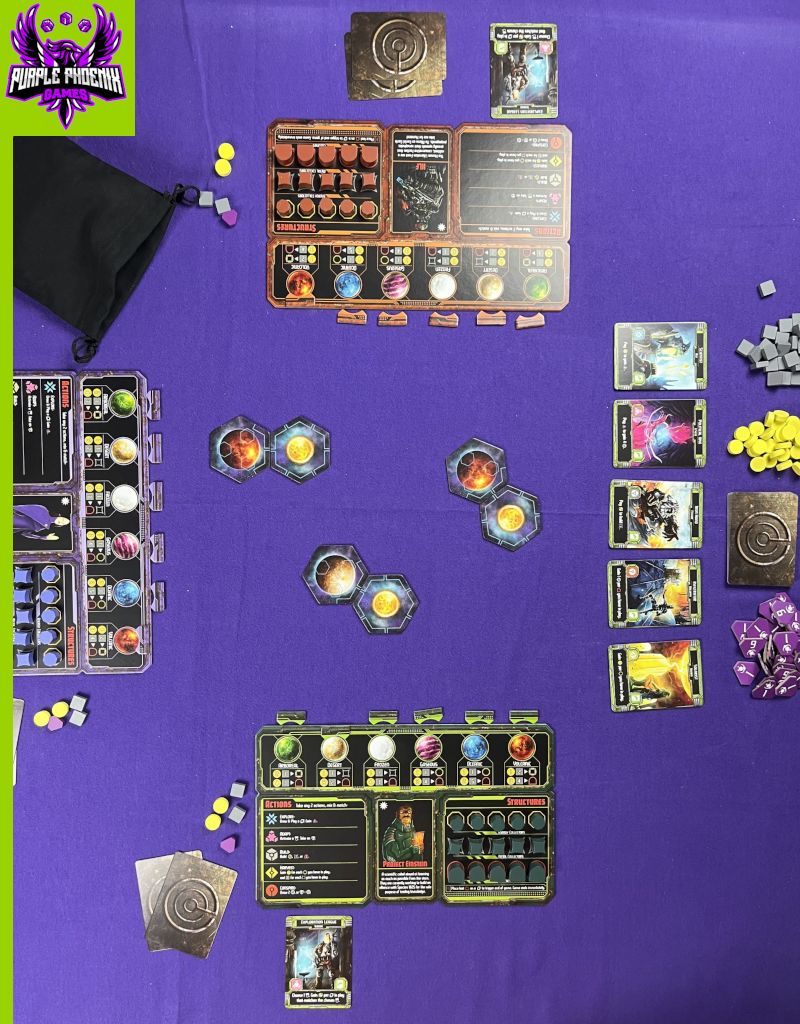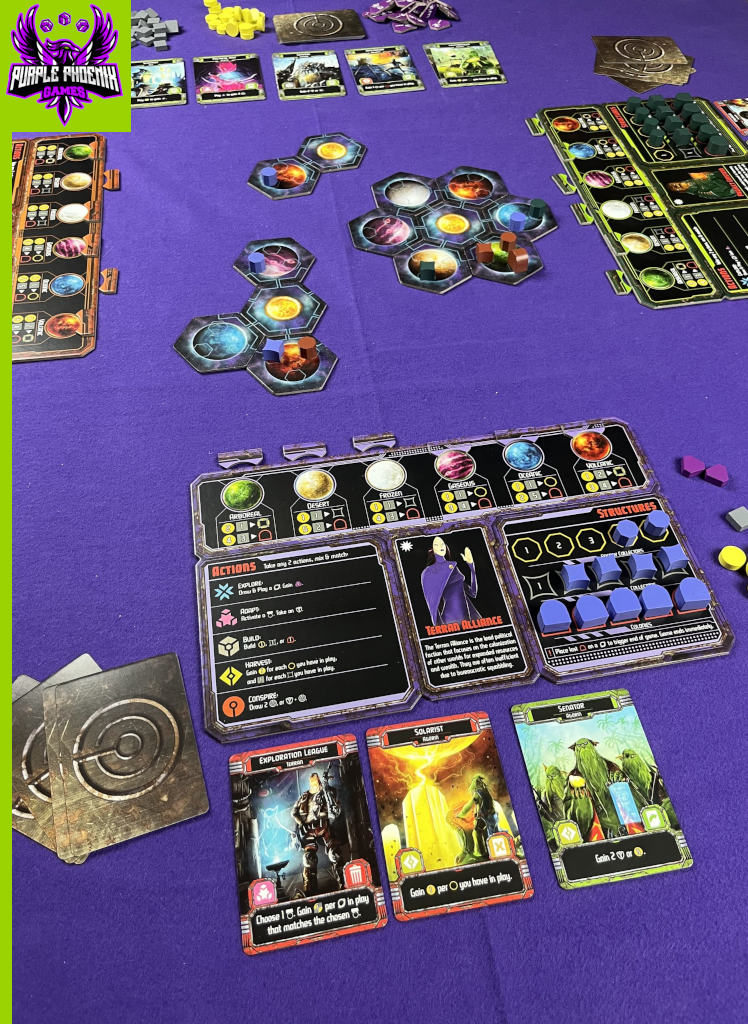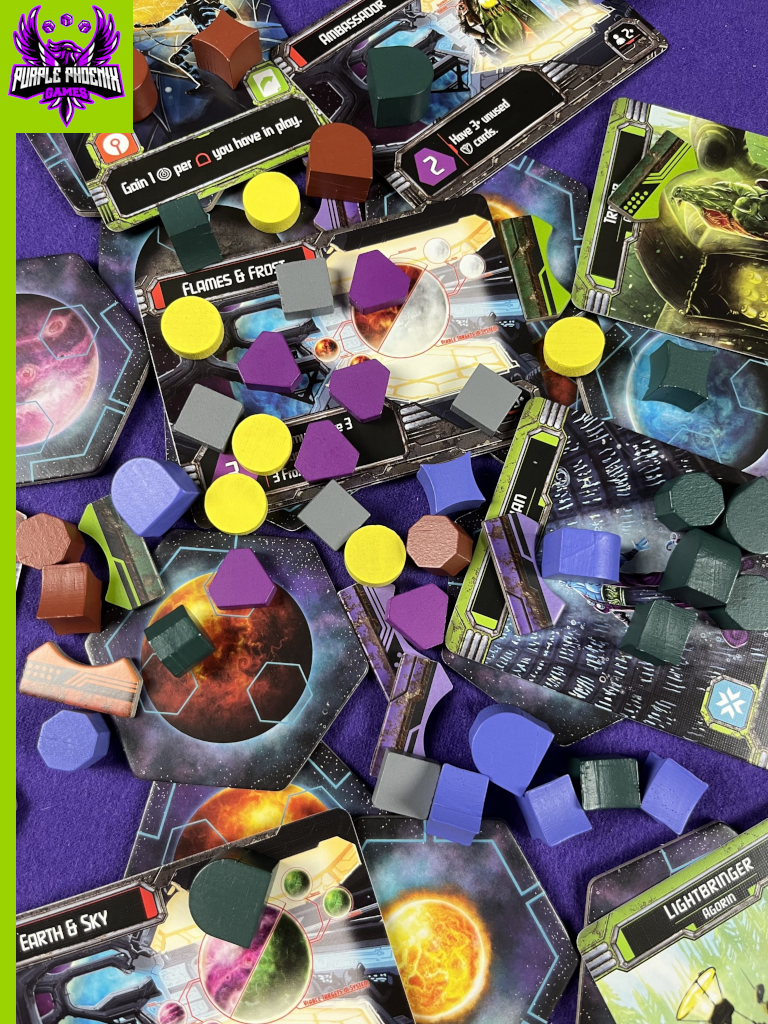
I’m back, baby! I know it’s been a bit since we’ve posted any reviews, but as Purple Phoenix Games isn’t my full-time job (unfortunately), life has been a bit hectic and has taken up my time. But fear not! We may take a hiatus sometimes, but we will always be back with more reviews, previews, and board-gaming goodness! So without further ado, enjoy this review of a great game with art by one of my faves, The Mico!
| Horizons (2018) | Daily Magic Games |
| 2-5 players | 60-75 minutes |
| Ages 14+ | BGG Weight – 2.63 / 5 |
Disclaimer – We were provided with a copy of Horizons for the purposes of this review. What you see pictured below are the finalized production components. I do not intend to rehash the entire rulebook in this review, but rather give a general overview of the rules and gameplay. For a more in-depth look at the rules, pick up a copy at your FLGS! – L
Horizons is a game of space exploration in which players take on the roles of various species exploring new galaxies and establishing colonies on different worlds. Over a series of rounds, players will take turns performing actions to build their civilizations to earn Victory Points (VP). When the game-end is triggered, the players with the most VP has successfully gained control of the galaxy and is declared the winner!
To setup for a game, each player receives a player board in their chosen color with matching tokens (Metal Collectors, Energy Collectors, Colonies, and Active World Markers), a Starter Ally card, and starting Resources. Shuffle the deck of Mission cards, deal 2 face-down to each player, and the remaining deck is placed face-down to the side of the play area. Shuffle and sort the Alien Ally cards by type, and place them to the side with the Mission deck. Place a number of Star tiles in the center of the play area equal to the number of players. Put all World tiles in the bag and setup the starting Galaxy as described in the rulebook, . Choose a starting player, and the game is now ready to begin! Pictured below is the setup for a 3-player game.

On your turn, you can perform up to 2 Actions, taking either 2 different Actions or the same Action twice. There are 5 Actions from which to choose: Explore, Adapt, Build, Harvest, and Conspire. If you choose to Explore, you will draw a World tile from the bag and place it, either side up, adjacent to a Star tile in the Galaxy, and gain 1 Knowledge token. To Adapt, choose one of the 6 World types in the game and place an Active World Marker on it on your player board. After placing your Active World Marker, you may draw 1 Alien Ally card from any of the face-up stacks to your tableau. To perform the Build Action, you spend resources from your personal supply to build a Metal Collector, Energy Collector, or Colony on any World in the Galaxy. One important thing to note is that you can only build on Worlds that you have adapted to (placed an Active World Marker on), so don’t forget that Action to setup for a Build! The cost to Build different structures varies, and some structures can only be built on certain World types. If you ever Build a structure on a World that already has another player’s structure, all players on that World gain 1 Resource of their choice!
In order to have Resources to spend, you can choose to perform the Harvest Action. For this Action, collect Metal or Energy tokens for each Metal or Energy Collector you have built on any Worlds across the Galaxy. For example, if you have 2 Metal Collectors and 1 Energy Collector, you gain 2 Metal and 1 Energy tokens. And finally, you can choose to Conspire. For this Action, you can choose to draw 2 new Mission cards, or draw 1 Mission card and 1 Alien Ally card. Mission cards are kept secret throughout the game, and can earn you end-game VP if you meet their requirements throughout the game. Alien Ally cards offer unique abilities to the player that has recruited them. Alien Ally cards have an Action trigger, so when you perform an Alien Ally’s corresponding Action on your turn, you can choose to trigger their power as well.
Once you have performed your 2 Actions, your turn ends. You cannot have more than 5 Alien Ally cards or 5 Mission cards in your hand, so discard extras if necessary. You can also only have a maximum of 10 Energy tokens and 10 Metal tokens, so discard any excess if necessary as well. The game continues on to the next player, who performs 2 Actions, and continues as such. When any player has built their last Colony, the game ends immediately and moves to Final Scoring. In Final Scoring, players tally up their total VP. Mission cards earn their printed VP if their requirements have been met, and Knowledge tokens are worth 1 VP each. Players then score VP for control over the Star systems in the Galaxy (Worlds surrounding each Star tile). Colonies are worth 2 Control Points (CP), and Metal/Energy Collectors are worth 1 CP. Players tally up their CP for a System and compare – the player with the highest CP earns 6 VP, and the player with the second-highest CP earns 3 VP. Tally up CP in this way for each Star system in play (dependent on the player count), and add those VP to your other total. The player with the most VP overall is the winner!

The gameplay of Horizons is pretty straightforward – take turns performing 2 Actions from a selection of 5 options. But the amount of strategy crammed into that simplicity is surprising. You really have to be playing a long game, as you have to set yourself up early to maximize your Actions in the late game. That being said, I did feel like the game took a few rounds to really get cooking. You really need to collect Resources as soon as possible so you can start Building, but you can’t collect Resources if you haven’t Built any Collectors. It was kind of a Catch-22. Obviously that’s not a game-breaking issue, as you kind of just have to bide your time and be strategic with your Build Actions, but it felt kind of counterintuitive at first. Back to strategy, there are several different elements you need to keep track of. It’s not just a race to build all your Colonies first, but its a puzzle of where to build everything. Control over each Star system can make or break your end-game score, so you’ve got to be paying attention to where your opponents are building their Structures, and how you can insert yourself to earn majority control.
One element of Horizons that I really like is how the Alien Ally cards work. They provide unique abilities, but are only triggered when you take their corresponding Actions. The cool part? You can choose an Action and not perform its effects, but still trigger your Alien Ally ability. It really gives you more strategic freedom in the gameplay, as you’re not forced to perform an Action you don’t want or you’re not being penalized for not being able to perform a specific Action. Just a neat element that I haven’t seen done in other games. My biggest gripe with the game is just a little bit of ambiguity in the rulebook. Mission cards are kept secret until the end of the game, but you can never have more than 5 Mission cards in hand at the end of your turn. But if you complete a Mission card on a turn, do you keep it in your hand? Do you just place it face-down to the side, knowing that you completed it? Do completed Missions count towards your 5 total cards in hand? We weren’t sure how to play that. Also, can you choose to discard Missions or Alien Ally cards even if you don’t have more than 5 in hand at the end of your turn? If you draw a Mission that you have no interest in completing, can you just discard it immediately? There’s no real clarification on that in the rulebook.
I’ll touch on components for a moment. The production quality is pretty great, and that’s no surprise coming from Daily Magic Games. The player boards and World tiles are nice thick, sturdy cardboard. The Resource tokens are little wooden chits that are easy to manipulate, and the cards are clear and easy to understand. I really like the plastic insert as well, as it has a separate space for each player’s pieces to go, so you don’t have to sit and sort out all the pieces during setup. The components that were our least favorite were the little cardboard chits used to signify which World types you have Adapted to. They are just kind of small, and they blend in really easily to the background of the player boards, so it’s hard to differentiate between the two sometimes. Perhaps having them a slightly different color, or having a cutout in the player board for them to slot into would make it easier to see? Not gamebreaking in any way, but just something that irked us a little bit. As I mentioned in my intro, the art is done by The Mico, and I’m a big fan of his style. It just works really well in this genre of game, and it adds to the overall experience of the game.
All in all, I liked Horizons more than I thought I would. Reading the rulebook seemed pretty straightforward and uncomplicated, so I was expecting kind of a run-of-the-mill gameplay. But what the rules can’t show is the strategy involved, and that’s where this game really shines. So many options to consider, it’s unlikely you’ll play the same game twice. This game isn’t new by any means (it came out in 2018), but I think it’s a perfect example that just because a game is ‘older,’ doesn’t mean it’s not good. We’re all always looking at the hot new games coming out that we sometimes forget about all the other games that have come before. Don’t sleep on Horizons, though. It’s one that I can’t wait to get back on my table. Purple Phoenix Games gives this one a stellar 10 / 12. Check it out if you’re wanting something ‘simple,’ yet strategic!

